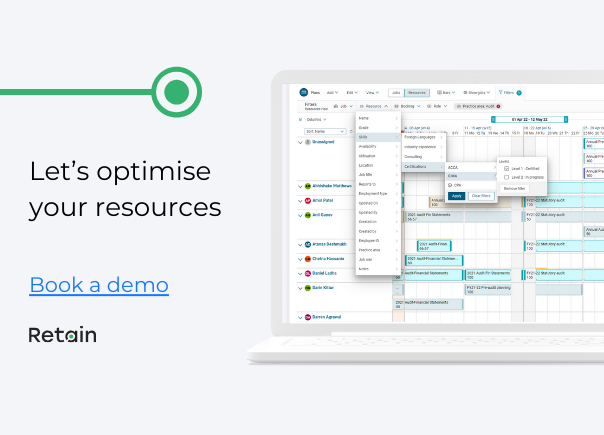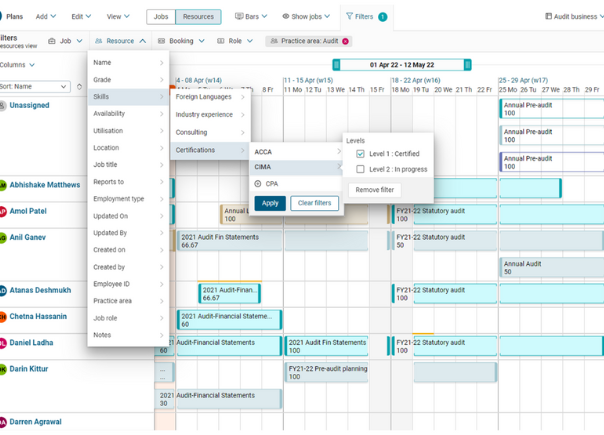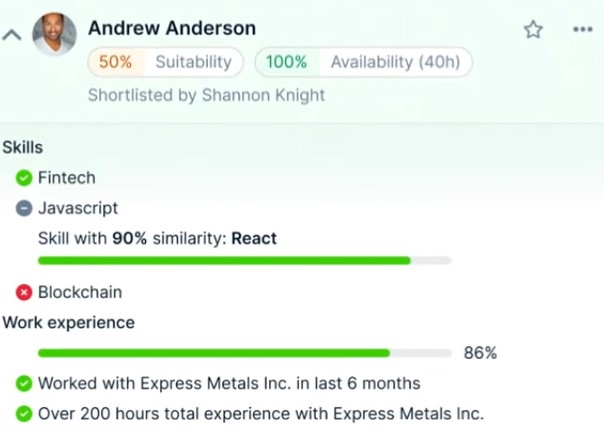It's Tuesday morning, and just as you're mapping out your day, your inbox pings: "Can we discuss the latest resource allocation plan?" You've got client meetings, team check-ins, and a never-ending list of tasks to juggle. Now this?
Resource allocation isn't a 'set and forget' game. It's dynamic, ever-changing, and essential for hitting those KPIs that keep everyone happy. Feel like you're constantly firefighting? You're not alone.
You need a solid strategy, one that turns chaos into order. As leaders in intelligent resource allocation tools, we're breaking down the best practices for making your resource allocation not just effective but human-centred.

The importance of resource allocation
When you're working in a fast-paced environment, each project has multiple moving parts. Team members need crystal-clear roles and deadlines to keep everything on track. That's why resource allocation is crucial.
By nailing down a solid resource allocation strategy, you achieve several things:
✅You eliminate project delays caused by resource conflicts or bottlenecks.
✅Clients gain clarity on project milestones and can see you're on top of things.
✅The entire team enjoys a seamless, less stressful work experience.
And if you don’t have a solid resource allocation strategy, you’re (probably) leaving money on the table.
So, what's the secret formula for creating a resource allocation plan to get everything flowing smoothly? Let’s take a look. ?
Why the right systems matter in resource allocation
Meetings are back-to-back, your inbox is piling up, and your team's asking about project timelines. It's not just another day; it's every day when you're juggling resources. You're not just tracking tasks but also people, skills, and availability. And let's face it, Excel just won't cut it anymore.
You need a robust system for resource allocation. Why? Because it puts an end to the guesswork. You'll know exactly who's doing what and when it's due. Here's what a reliable system gets you:
- No more tasks in limbo due to a lack of clarity on responsibilities.
- Teams and clients alike know what to expect at each stage.
- You create an efficient, stress-free experience for everyone involved.
If you’re reading this and thinking “I need to know how to do this,” here are a few ideas to help you get started.?
8 human-centred resource allocation best practices
Resource allocation isn't just about assigning tasks and ticking boxes; it's about making the system work for the people in your team. Here are some of the best practices that'll make your resource allocation strategy truly effective:
#1: Choose your platform wisely
A solid resource allocation strategy starts with the right tool. To quote Wellingtone:
“Only 23% use a PPM or Resource Management software solution, with many organisations yet to benefit.”
For most professional services firms, the solution is Retain. As a company specialising in resource management and trusted by firms like KPMG, EY, and Grant Thornton, you can be confident it has all the features you will need.
You may have another tool in mind, but make sure you do your research and understand the key features you need for resource allocation. In fact, our blog on how to choose the best resource management software covers exactly that.
In other words, don’t base your resource allocation strategy on spreadsheets or inadequate tools.
#2: Establish a central resource pool
The key to effective resource allocation? A centralised resource pool. Think of it as a comprehensive directory where you can view all available resources, from skills to availability, in real-time. This isn't a 'nice-to-have'; it's indispensable.
Without real-time insights, Wellingtone’s report says 36% of Project Managers are spending between four hours and one day manually collating information.
By consolidating this information in one place—with platforms like Retain—you empower your project managers. You can then search by role, skills, team, or even special tags to find the perfect match for your project's needs.
Get this right, and you make informed decisions that lead to successful projects.
#3: Understand capacity and availability
First things first: you can't allocate what you don't have. Knowing the exact capacity and availability of your resources is fundamental. Are some team members only available on Tuesdays? Is there a bank holiday that will impact work hours? These are the kinds of questions you need answers to.
What’s the difference? Capacity relates to the total work hours someone is available for. Availability, on the other hand, is that capacity minus any commitments like holidays, sick leave, or other projects. The two can often be worlds apart, so never assume.
A tool like Retain offers a comprehensive view of everyone's workload, time off, and true availability. This enables you to make informed decisions, creating realistic workloads and project timelines. Our dashboard provides a birds-eye view, allowing you to focus on roles crucial to your project's success.

#4: View pipeline visibility for optimal resource allocation
Clarity is king when it comes to managing multiple projects. You need to know what's in progress and what's on the horizon to allocate resources effectively. It's especially crucial when team members are juggling more than one project.
A specialist tool can lay out all scheduled projects within a selected timeframe, showing you the current state of play. Keep an eye on tentative projects; their confirmation will require you to readjust your resource allocations accordingly.
And here’s the best part: You will spot potential overcommitments quickly, which helps you to maintain balanced workloads and sidestep overcapacity blunders.
#5: Understand scope and constraints for seamless project delivery
Once you have your tools set up to show projects in your pipeline - and how many people and hours you have available - you’re in a better position to allocate these resources intelligently to specific projects.
This involves defining the project scope, locking in deadlines, and recognising dependencies. Knowing these constraints helps set realistic expectations and prevents unnecessary bottlenecks.
One thing to note: Communication is your best ally here. Engage with stakeholders at every level to ensure everyone's on the same page.
#6: Pinpoint the right expertise
Before a project kicks off, you’ll need to identify the roles, skill sets, and experience levels required. This sets the stage for a more focused and efficient process.
The right tool will provide valuable insights. You can easily look up your team's capabilities and workloads. The right tool will also offer suggestions for ideal role allocations or highlight skill gaps.

If you're working with a defined budget, Retain's budgeting feature helps organise these roles and provides an estimate of how much budget will go towards each. This not only aids in resource planning but also ensures you're financially on track.
#7: Keep an eye on utilisation rates and sustainable workloads
When you're in the thick of project management, it's easy to overlook the human aspect of your team. People need breaks, have to attend meetings, and yes, spend a significant chunk of their day handling emails.
Retain's features allow you to monitor how much of a team member's time is booked and how much is billable. The key is to aim for an 80% rule: assume that 100% of a person’s time is available for work and, within that window, 80% is for billable tasks. Exceeding this limit risks overburdening your team and jeopardising the project.
Utilisation rates give you a realistic snapshot of your team's capacity. Align this data with your project requirements to create not just a productive but also a human-friendly work environment.
#8: Continuously monitor and adapt resource management
Unexpected things happen. Factors like scope creep and inaccurate estimates could throw your project off course. Monitoring is crucial for detecting early signs of risk in your resourcing and scheduling.
Retain's built-in features offer a wealth of data, from timesheets to reports. These tools allow you to compare your original plans with the current reality, providing you with actionable insights. For example, you can identify any gaps between your actual and planned resource allocations.
This continuous monitoring enables proactive decision-making. Depending on what the data reveals, you might need to make several adjustments. You could swap out a resource, bring additional team members into the fold, tweak your timeline, or even renegotiate project deliverables. The aim is to stay agile, pivot where necessary, and keep your project on track.
?Key point: Put people before projects
It might go against the grain of traditional project management, but the real key to effective resource allocation is putting your team first. When you focus on creating a system your team will genuinely embrace, you set the stage for a smoother, more efficient workflow.
In the end, resource management is about empowering your team to do their best work. You give them work that aligns with their skills and interests, communicate requirements, work with them on their bandwidth—and then watch them do their part in delivering successful work.
You're not just assigning tasks; you're facilitating a space where each team member can contribute meaningfully to projects that best suit them.
Wrapping it all up
So, there it is. That's how you can turn your ever-changing resource allocation challenges into a finely-tuned system. All with a team of various skills, multiple ongoing projects, and the inevitable curveballs.
Or, more broadly, it’s how you can approach resource allocation to cultivate a more harmonious, productive work environment.
Engage your team to understand their needs, use their feedback to optimise your systems, and make adjustments that keep projects on track.
Resource allocation that starts with team engagement—and finishes with project success.
How we can help
Retain offers real-time insights and a comprehensive view of both your project pipeline, employee skills, and resource availability. This enables you to allocate resources precisely, respond to changes efficiently, and maintain an agile approach to project management.
Key features include:
- A centralised resource pool with dynamic skills matching
- Detailed profiles for understanding skills, experience, and availability
- Time tracking and utilisation features
- Intuitive drag-and-drop functionality for seamless planning
- Robust monitoring tools for timely adjustments and resource optimisation
Take control of your resource allocation. Experience Retain's capabilities with a personalised demo.
Or if you're looking for more insights, you might like these:
?Where do you sit on the resource management maturity model?


